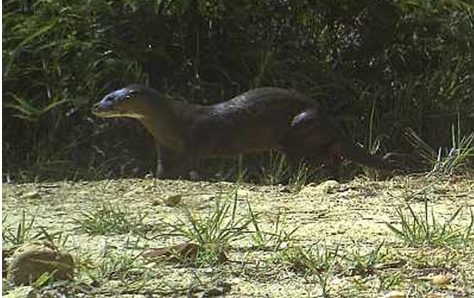IUCN/SSC Otter Specialist Group Bulletin

IUCN/SCC Otter Specialist Group Bulletin
© IUCN/SCC Otter Specialist Group
Volume 27 Issue 2 Pages 59 - 122 (June 2010)
Information
Previous | Contents |
Next
Husbandry Practices for ex-situ Care of Lutra lutra
It is with gratitude and pleasure I inform you that the summary of recommended husbandry practices for ex-situ care of Lutra lutra, written by Carol Heap, Lionel Fontaine, and David Heap using Melissen’s husbandry manual as a foundation, has been translated into Italian by Lorenzo Queglietta. It is now available on the OSG website, under library and the Otters in Captivity Task Force (follow this link).
Many thanks and our deepest appreciation go out to Lorenzo for doing this translation for us and the community working with otters in Italy.
Soon we will have the N.A. river otter and Training OCT documents available
in German.
Please if you work with or have contacts with Italian facilities housing
this species let them know this document is now available.
Jan Reed-Smith
Chair, Otters in Captivity Task Force
jrsotter@iserv.net
World’s most endangered otter ‘rediscovered’ in Deramakot
July 25, 2010http://www.themalay sianinsider. com/features/ article/worlds- most-endangered- otter-rediscover ed-in-deramakot/
 |
|
The “rediscovered” hairy-nosed otter (Lutra sumatrana) is photographed by an automated camera trap set up by ConCaSa. — Photo courtesy of Mohamed & Wilting, SWD, SFD. |
KOTA KINABALU, July 25 - The world’s most endangered otter species, known as the hairy-nosed otter (Lutra sumatrana), has been “rediscovered” in Deramakot Forest Reserve in Sabah by a team of German and Malaysian researchers.
“This is great news for Sabah and shows once again how unique and fortunate we are in terms of wildlife and nature. In addition, these findings also boost the conservation of this endangered otter internationally as historically this otter was distributed throughout large parts of southeast Asia,” said an elated Sabah Wildlife Department Director, Dr Laurentius Ambu. The last confirmed record of the hairy-nosed otter in Sabah is a museum specimen collected over a hundred years ago.
Even over the whole island of Borneo, the last record – a road-kill from Brunei – was 1997, over ten years ago. Therefore it was unknown to scientists if this species can be still found on Borneo,” stated Andreas Wilting, the project leader of the Leibniz Institute for Zoo and Wildlife Research (IZW).
In 2008, IZW initiated the Conservation of Carnivores in Sabah (ConCaSa) project with the collaboration of SWD and Sabah Forestry Department (SFD) to study carnivores such as the Sunda clouded leopard, civets and otters in the state.
The ConCaSa project used automated camera traps that were set up in Deramakot and the surrounding forest reserves during the last two years. As the different otter species look very similar the hairy-nosed otter, pictures had to first be verified by a number of experts before they were published recently by the International Union for Conservation of Nature (IUCN) Species Survival Commission journal.
In addition to capturing camera trap pictures of the endangered hairy-nosed otter, the study also confirmed the presence of five Bornean cat species, as well as 13 other small carnivores such as the Banded civet and the sun bear.
“These results mean that out of 25 known carnivore species in Borneo, our project, together with a Japanese researcher Hiromitsu Samejima, confirmed 20 in Deramakot. This makes Deramakot outstanding for being extremely rich in its diversity of carnivores,” explained Wilting.
Besides the pictures, ConCaSa also obtained the first video footage ever taken of some species, such as the otter civet (Cynogale bennettii).
Since 1997, Deramakot Forest Reserve has been managed by the SFD as a sustainable logged forest with the coveted Forest Stewardship Council certification.
“These findings show that long-term sustainable forest management is of great importance for the protection of some of this country’s most threatened species and of the unique biodiversity of the forests of Borneo,” shared Datuk Sam Mannan the Director of the SFD.
One of the next steps in the conservation of Bornean carnivores is the First Borneo Carnivore Symposium in Kota Kinabalu, in June 2011.
This symposium organised by the SWD, three IUCN/SSC Specialist Groups and
the IZW will be a landmark international meeting, bringing together scientists,
government agencies and non-governmental organisations (NGO) working on the
protection of the Bornean carnivores.